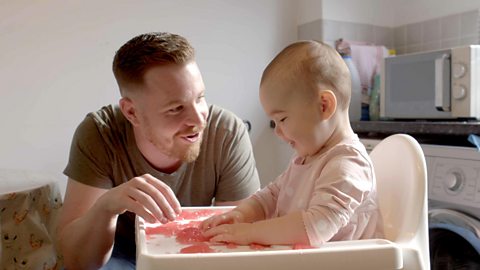Even though your baby probably won't start saying their first words until they're around 12 months old, there are loads of ways you can help boost their language skills from day one.
We spoke to Speech and Language Therapist Sinead Campbell to find out some simple ways to help your baby's language in the first year.
Watch the video below to hear the tips and see them in action.
Sinead:
Even if you make them up, little ones love hearing the same songs over and over again, and it's a really useful way to help them learn to talk.
They're learning all about rhyming words and where words go in sentences.
Sinead:
Babies learn to communicate with movement before they learn to communicate with words. So try using lots of actions.
Mum 3:
Do you want to have a drink? Drink?
Sinead:
They will remember these actions and this will help them to develop words later on.
Mum 2:
Book! Do you want to read a book?
Sinead:
When your baby can see you it's easier for them to pay attention to you. When they can see your lips moving, they're learning all about how sounds are made.
Mum 1:
Shall we take this off? Yes? Shall we take it off? Ready? I know!
Sinead:
If your baby smiles at you, smile back.
By smiling at them, you're teaching them a really important communication step. They've just learnt they can look at you and do something and you immediately respond.
Sinead's tips to help your baby learn to talk
1. Sing rhymes and songs
Even if you make them up, little ones love hearing the same songs over and over again, and it's a really useful way to help them learn to talk.
They're learning all about rhyming words and where words go in sentences.
Because nursery rhymes exaggerate and repeat predictable rhythms, they can help children spot where words begin and end in a sentence as well.
There are loads of benefits of singing nursery rhymes with babies and pre-schoolers.
If you've not sung a rhyme in a while and need a refresher on the lyrics, check out our bank of nursery rhymes and songs.

2. Use gestures and actions
Babies learn to communicate with movement before they learn to communicate with words. So try using lots of actions.
They will remember these actions and this will help them develop words later on.
Although some parents worry that using signing and gestures will stop their child from talking, this isn’t the case. Research shows it helps children learn language. As a parent, it's important to remember to always say the word at the same time as using any signs or gestures.
There are lots of ways you can help your baby communicate in the first year that will help their language development. Find out more about using objects, pictures and signs.
3. Let your baby see your face
When your baby can see you it's easier for them to pay attention to you.
They respond to eye contact right from birth. So it's good to be at their level when you're face to face.
When they can see your lips moving, they're learning all about mouth movements and how sounds are made.
Find out more about baby's developing vision in our Speech Lab.

4. Copy your baby
If your baby smiles at you, smile back.
By smiling at them, you're teaching them a really important communication step. They learn that they can look at you and do something, and you immediately respond.
It doesn't just have to be smiling! Whenever your baby does anything or makes any noise or babble, you can respond.
As they get older, this idea of turn-taking will follow through into their conversations with you.
Find out why these mini-conversations are so important for your baby.






